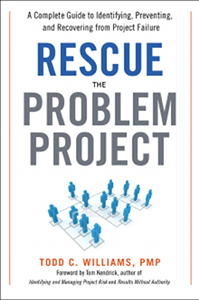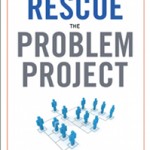Addressing project failure
Posted by Elena del Valle on October 17, 2014

Rescue the Problem Project
Photos: Visibility Strategist
For years Todd C. Williams was the informal go to person when a problem project needed attention. He would discuss the project issues with the team in charge and pass his ideas back to the decision makers. They would in turn review them and eventually, if he succeeded in convincing them, approve them. In time, he fine tuned his process and went up the ranks. Now he is president and executive consultant at eCameron, Inc., a project rescue company based in the state of Washington.
In his book, Rescue the Problem Project: A Complete Guide to Identifying, Preventing, and Recovering from Project Failure (AMACOM, $39.95), he explains how he and his team identify a problem project, and how they recover it before it fails or has to be canceled. He shares with readers his process for rescuing red projects that focuses on root cause correction and prevention. He points out that 65 percent of projects fail to meet their goals and 25 percent of projects require cancellation.

Todd C. Williams, author, Rescue the Problem Project
The 277-page hardcover book published in 2011 is divided into twenty chapters and six main parts: Understanding the Process and Realizing a Problem Exists, Auditing the Project: Understanding the Issues, Analyzing the Data: Planning for Project Recovery, Negotiating a Solution: Proposing Workable Resolutions, Executing the New Plan: Implementing the Solutions, and Doing It Right the First Time: Avoiding Problems That Lead to Red Projects. He relies on case studies, mostly from manufacturing and information technology projects, to illustrate his steps and process. The end of each chapter includes a summary or Chapter Takeaway.
In the book, he identifies aspects he relies on in his problem solving: the team holds the answers, a strong team can solve most problems, remaining involved with the team is essential, and it is important to remain involved with the team in order to resolve the situation. He also describes his recovery process steps: realizing there’s a problem, figuring out what the problem is, identifying the causes for the problem and the possible solution, negotiating a solution everyone can agree on, and implementing the steps to solve the problem. He points out that it is essential for management to recognize that there is a problem before any of the other steps can be taken and the project rescued.

Click to buy Rescue the Problem Project









